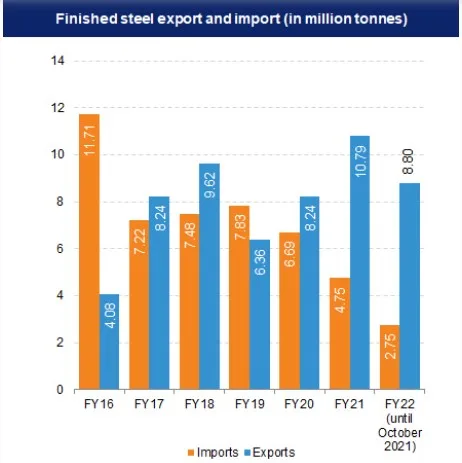Syllabus: GS3/ Economy
Context
- The Union Minister of Commerce and Industry, during his address at the 5th edition of ISA Steel Conclave set a target of 500 mn tonnes of steel production by 2034.
Status of Steel Production in India
- India is the world’s second-largest producer of crude steel, surpassing Japan in 2018.
- In FY24, the production of crude steel and finished steel stood at 143.6 MT and 138.5 MT, respectively.
- India’s finished steel consumption stood at 119.17 MT in FY23 and 138.5 MT in FY24.
- In FY24, the exports and imports of finished steel stood at 7.49 MT and 8.32 MT, respectively.
- The per-capita consumption of steel stood at 86.7 kgs in FY23.

Potential of Steel Sector in India
- Easy availability of low-cost manpower and presence of abundant iron ore reserves make India competitive in the global set up.
- India is home to fifth-highest reserves of iron ore in the world.
- India surpassed China as the top developer of coal-based steel capacity in July 2023, according to the latest report from Global Energy Monitor (GEM).
- Automobile Industry Growth: The automotive sector is a major consumer of steel.
- As India’s middle class expands and consumer purchasing power increases, there is a growing demand for automobiles, contributing to the demand for steel.
- Urbanization: With a growing population and increasing urbanization, there is a rising demand for housing, commercial spaces, and urban infrastructure. This trend contributes to a sustained demand for steel in construction and real estate sectors.
Concerns for Steel Sector in India
- Raw Material Availability and Cost: The steel industry heavily depends on the availability and cost of raw materials such as iron ore and coking coal.
- India remains dependent on imports to meet 90% of its coking coal requirement.
- Global Competition: The steel industry is highly competitive and Indian steel manufacturers face stiff competition from international players.
- Dumping of steel products especially from China and Vietnam in the past had major impacts on the industry.
- Infrastructure Bottlenecks: Inadequate transportation facilities, inefficient logistics, and power shortages, hinder the smooth operation of the steel industry. It also leads to increased production costs.
Read more: Steel Industry in India
Steps taken by Government
- National Steel Policy 2017 (NSP 2017): India has set the targets of achieving the total crude steel capacity of 300 MTPA (million tonnes per annum) and total crude steel demand/production of 255 MTPA by 2030-31.
- In 2019, the Government introduced Steel Scrap Recycling Policy with an aim to reduce imports.
- Policy for providing preference to Domestically Manufactured Iron and Steel Products (DMI & SP Policy) in government procurement which has resulted in import substitution of ₹34,800 Crore approximately.
- Brand India labeling: the Ministry of Steel has undertaken the initiative of Made in India branding of Steel produced in the country to differentiate Indian quality steel from the others.
- In 2021, India and Russia signed an MoU to carry out R&D in the steel sector and produce coking coal (used in steel making).
- In 2021, took initiative to boost the steel sector through joint activities under the framework of India–Japan Steel Dialogue.
- Productivity Linked Incentive Scheme (PLI) for steel: The Scheme was approved by the Government in 2021, with a financial outlay of ₹ 6,322 crores.
- Objective: To promote domestic manufacturing of ‘Specialty Steel’ within the country by attracting capital investment, generate employment and promote technology up-gradation in the steel sector.
- The “Promotion of Research & Development in Iron & Steel Sector” scheme provides financial support to stakeholders for initiatives aimed at promoting environmental sustainability and reducing carbon emissions.
- Government allowed 100% Foreign Direct Investment (FDI) in the steel sector under the automatic route.
- According to the data released by the Department for Promotion of Industry and Internal Trade (DPIIT), between April 2000-March 2024, Indian metallurgical industries attracted FDI inflows of US$ 17.51 billion.
Way Ahead
- There is a need for innovation in achieving low emissions, high productivity, and superior quality to position India as a leading global steel manufacturer.
- The use of artificial intelligence (AI) is required to optimize production, minimize waste, and enhance efficiency throughout the value chain.
- Also there is a need for a level playing field for domestic industries and addressing the Carbon Border Adjustment Mechanism (CBAM) with steel industry leaders to promote sustainable manufacturing.
Source: TH
Previous article
PAC to Hold Performance Review of Regulatory Bodies
Next article
News In Short-06-09-2024